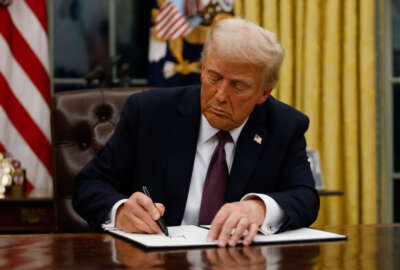Don’t try this at work: smuggling pepper spray into your federal office
The Government Accountability Office did what you might call a pressure test, to see if dangerous items could get past guards in federal buildings.
A new chapter in a long-running story. It’s too easy for the wrong people to sneak the wrong things into federal buildings. The Federal Protective Service provides the mostly contracted guards. The Government Accountability Office did what you might call a pressure test, to see if dangerous items could get past them. The results show there’s work to do. Joining the Federal Drive with Tom Temin with the details, the GAO’s director of physical infrastructure issues, Dave Marroni.
Interview transcript:
Tom Temin Mr. Marroni, good to have you back.
David Marroni Happy to be here, Tom.
Tom Temin And just review for us briefly where Federal Protective Services lives in the federal hierarchy.
David Marroni So, it’s within the Department of Homeland Security. It provides security for GSA controlled buildings.
Tom Temin Okay. And it used to be GSA at one time.
David Marroni It did, before 9/11. After 9/11, it shifted over to DHS.
Tom Temin Okay, you got to keep those chess pieces in your eyes. Let’s start with what GAO did here. You were tasked with trying to see what would happen if you tried to get the wrong things in. Tell us the methodology and what happened.
David Marroni Right. So, we were looking at two long standing challenges that FPS has had in providing security at federal buildings. First, we looked at how effective is contract guards who secure these buildings and control access to them, how effective they are at detecting and preventing prohibited items like pepper spray, batons, knives, from getting into those buildings. And then secondly, we looked at the systems that FPS uses to oversee those contract guards and how effective those are as well. And the bottom line is we found issues with both areas.
Tom Temin And you went to a selected number of buildings with these illicit items to see if you could get them through. How did that happen?
David Marroni Correct. So, we did a total of 27 covert tests where we had investigators go to 14 different buildings throughout the country, and they had backpacks with prohibited items in them. So in our case, we use pepper spray, a baton and a multipurpose tool with a knife, things you wouldn’t want to get through and have on the other side, they could cause real harm if someone had mal-intent. And we simply went through the screening process. Can we get this back through with this prohibited item? Well, the contract guards catch them through screening.
Tom Temin And screening, I guess consists of putting the backpack on a conveyor going through a metal detector.
David Marroni So, it depends on the facility, a lot of times it will be what you’ve described going through a piece of equipment for them to be scanned. Sometimes it might involve the guard going through the bag, using their hands using a baton. But basically, looking at the bag, seeing what its contents are and trying to detect the prohibited item.
Tom Temin And pepper spray, as I understand, it is a small canister, like one of those travel size shaving cream type sized can.
David Marroni Yes, that’s generally correct.
Tom Temin And they’re metal. So if it’s metal, you would expect someone to see what the metal is surrounding you would.
David Marroni And for all these items, you would expect going through the equipment that’s in place or through the guard going through the bag itself, you’d expect them to be able to take that they’re trained to do so.
Tom Temin And the baton is not a cheerleading baton, but some kind of a hard blunt stick that can be used as a weapon.
David Marroni Exactly.
Tom Temin Alright, and how often, you said you did 27 checks, how often did the things get through that should not have?
David Marroni So, 13 times, about half, which is not where you want to be.
Tom Temin Sure. And were you at headquarters types of buildings, or what types of facilities in the range were there?
David Marroni So, we had a mix, we were all across the country, we did some in the DC area, but also outside of the DC area, some large facilities, some smaller and different levels of risk. They all had public access. So, the public could come into any of these facilities, but they were arranged. And we did that on purpose to try and get a mix, even though it’s a small sample size, to try and see if it made a difference.
Tom Temin And by the way, is there signage or some sort of indication for visitors of what is prohibited? Obviously firearms, you can imagine, and knives, but what about those other items?
David Marroni Right. Generally speaking, there’ll be a list of these are items that are not allowed in the facility. And if someone still tries to bring them in, the guards are supposed to detect them. And if it’s an item that’s legal, just can’t be allowed in the building, say, pepper spray may be illegal outside of the building. Person is directed to remove the item from the building. And if it’s something that’s illegal then the guard is to detain that item.
Tom Temin We’re speaking with Steve Marroni, director of physical infrastructure issues at the Government Accountability Office. And you also examined the I guess, the upstream systems for screening guards, and the information technology that is supposed to track what has happened with respect to training and so forth. And what did you find there?
David Marroni So, really significant problems. And this has been a really stubborn challenge for FPS for over a decade and a half that we’ve been looking at this. And these systems are really important because this is how FPS oversees the contract guards. It’s how it makes sure that posts are being staffed appropriately with qualified guards at the times when they’re supposed to be it’s how they track billing. It’s how they track all sorts of things about the contract guard program over 13,000 contract guards that they have to provide oversight for and what we found is these systems still are not where they need to be, for example, one of the systems that’s meant to track that a qualified guard is that post at the times they’re supposed to be started to be developed over 10 years ago, was piloted six years ago and still haven’t fully implemented any region in the country and has some major issues beyond that as well.
Tom Temin So, in other words, there’s almost a blind spot on the part of FPS management as to who has been trained properly for what?
David Marroni Well, it’s certainly inefficient that they have that information, but it’s not in a centralized system. So, a lot of this involves manual data entry paper-based systems in this digital age, which prevents you from having the kind of real time information you’d want and should have at this point.
Tom Temin All right, so then I can imagine what your main recommendations were, let’s review those.
David Marroni So, we are actually still in our engagement right now. I gave a testimony last week on our preliminary results. So, we don’t have recommendations yet. I fully expect we will, when the final report for this comes out in later this year. But I think the bottom line is clear at this point, which is FPS needs to pay sustained attention and take deliberate action both to improve its detection of prohibited items. And secondly, to address these longstanding concerns on its data systems.
Tom Temin Right. So, when you do have the recommendations and present these findings to FPS, it’s unlikely to be a horrible shock to their system, because you’ve been working on this for 15 years.
David Marroni Right. I think the areas of concern are going to be readily apparent, both of those areas need sustained attention and fixes.
Tom Temin Has there ever been any thought over the years to converting the contracted guards to federal employees along the lines of say, Transportation Security Administration, which has a similar process, you might say?
David Marroni So, there certainly have been discussions along those lines. And we haven’t weighed in on what’s which way to go. What I’d say is whether it’s federalized guards or contract guards, the important thing is that they have the training they need. And then FPS has the oversight mechanisms that it needs to make sure they are fully capable and doing the job.
Tom Temin And by the way, when you were able to get through a screening center, a screening station at a federal building with those items, did you turn around and say, aha, I’m from the GAO and look what you let through?
David Marroni We did not. So, we wanted our investigators to maintain their anonymity. So, if they got through with the item, they went through the building, came back out. And then in some cases, we then tested another item to go through that same facility to check is it going to happen more than once?
Tom Temin Right, and often, at least at some of the federal buildings I’ve been to, there might be multiple stations. By the way, did you go to any congressional office buildings, because those are, tend to be, big lines outside, you know, in high season?
David Marroni So, we were only going to FPS protected facilities. So, that does not include congressional offices.
Tom Temin Okay. And well, my question was going to be, did the same guard maybe get tested twice? Or did you try more than one station and still got through?
David Marroni So, it was a variety of guards that we were testing. So, it wasn’t a single guard. It was a variety across these 27 tests, which, granted, is a small sample, but our results were consistent with the results of FPS his own covert testing program, which is much more extensive. So, definitely cause for concern.
Tom Temin Yes, I remember a number of years ago, the GAO did a similar type of test in which they took components of explosives through on separate occasions, and showed that they could be assembled into a finished explosive on the other side of the guard station. And I think they did the same thing with pieces of firearms that were then assembled. Any thought of repeating that particular program?
David Marroni So, we did that back in 2009. And the good news is FPS has taken a number of steps that has been to improve its program, in fact, including putting in this covert testing program, which it did not used to have still a long way to go. We did not repeat those tests this time. One because we wanted to test what are still prohibited items, right? Knives, batons, pepper spray that could cause real harm, but someone might bring by mistake, so that when our investigators went through the system, if detected, it would be a good test without potentially escalating into a situation if it was a an IED, which it’s hard to imagine a reasonable reason to be bringing that through a system.
Tom Temin All right, well, we’ll look for those recommendations. In the meantime, Dave Marroni is director of physical infrastructure issues at the Government Accountability Office. Thanks so much for joining me.
David Marroni Thank you, Tom. And we’ll post this interview along with a link to his testimony at federalnewsnetwork.com/federaldrive. Subscribe to the Federal Drive wherever you get your podcasts.
Copyright © 2025 Federal News Network. All rights reserved. This website is not intended for users located within the European Economic Area.
Tom Temin is host of the Federal Drive and has been providing insight on federal technology and management issues for more than 30 years.
Follow @tteminWFED






